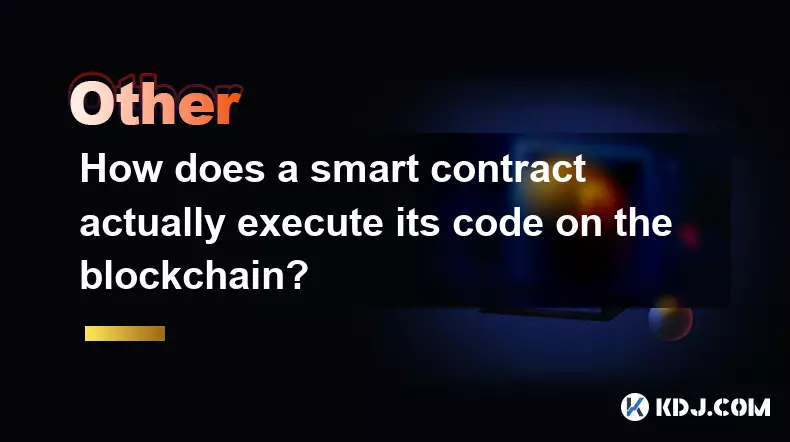-
 bitcoin
bitcoin $99296.318777 USD
-2.82% -
 ethereum
ethereum $3203.465899 USD
-6.84% -
 tether
tether $0.999590 USD
-0.03% -
 xrp
xrp $2.308913 USD
-4.00% -
 bnb
bnb $922.788929 USD
-3.53% -
 solana
solana $144.020807 USD
-5.89% -
 usd-coin
usd-coin $0.999798 USD
0.00% -
 tron
tron $0.291590 USD
-1.12% -
 dogecoin
dogecoin $0.163780 USD
-4.46% -
 cardano
cardano $0.526919 USD
-4.40% -
 hyperliquid
hyperliquid $37.888865 USD
-2.24% -
 bitcoin-cash
bitcoin-cash $510.515457 USD
-1.08% -
 chainlink
chainlink $14.436987 USD
-5.63% -
 stellar
stellar $0.267345 USD
-4.77% -
 unus-sed-leo
unus-sed-leo $9.175222 USD
0.53%
How does a smart contract actually execute its code on the blockchain?
Smart contracts execute in a decentralized, deterministic environment where nodes validate transactions, enforce consensus, and apply state changes only after full verification.
Nov 11, 2025 at 09:00 pm

Understanding the Execution Environment of Smart Contracts
1. Smart contracts operate within a decentralized network, where every node maintains a copy of the blockchain ledger. When a contract is deployed, its bytecode is stored on the blockchain and assigned a unique address. Each participating node in the network runs a virtual machine—such as the Ethereum Virtual Machine (EVM)—capable of interpreting and executing this bytecode.
2. The execution environment ensures consistency across nodes by enforcing deterministic behavior. This means that given the same input and state, every node must produce identical results when running the contract code. Non-deterministic functions, like accessing current time or random numbers, are either restricted or simulated through consensus mechanisms.
3. Transactions that interact with a smart contract trigger its execution. These transactions contain the sender’s address, the target contract address, encoded function calls, and optional data. Upon receipt, nodes validate the transaction signature and gas limit before initiating execution.
4. Gas serves as a unit of computational effort. Every operation in a smart contract consumes a predefined amount of gas, preventing infinite loops and abusive computations. If the provided gas is insufficient, the execution halts and any state changes are reverted, though the gas fee is still charged.
5. Once validated, the transaction is included in a block by miners or validators. The block proposer executes the contract code and broadcasts the resulting state changes. Other nodes independently re-execute the same transaction to verify correctness, ensuring consensus without trust.
The Role of Nodes in Code Execution
1. Full nodes download and store the entire blockchain history, including all smart contract code and storage states. When a new transaction arrives, they replay the contract logic from genesis to ensure the current state is accurate before processing new inputs.
2. Execution begins when a node receives a transaction targeting a contract. The node retrieves the contract’s bytecode from its local storage and loads it into the EVM. Input data from the transaction determines which function is invoked and what parameters are passed.
3. During execution, the EVM processes opcodes sequentially, managing memory, stack, and storage. Any modifications to the contract’s state—such as updating variables or transferring tokens—are temporarily held until the transaction completes successfully.
4. Nodes maintain logs of events emitted by the contract, which are not part of the state but can be queried externally. These logs help off-chain applications track contract activity without scanning the entire blockchain.
5. After execution, each node produces a result: success with state updates, failure with rollback, or out-of-gas exception. Only after consensus on the block’s validity do these changes become permanent in the global state.
Transaction Lifecycle and State Changes
1. A user initiates interaction by signing a transaction that specifies the recipient contract and function call. Wallet software often encodes the function selector and arguments using ABI standards before broadcasting the transaction to the network.
2. Pending transactions enter the mempool, where miners or validators select them based on gas price and availability. Higher-paying transactions typically receive priority inclusion in the next block.
3. When constructing a block, the validator executes each selected transaction in sequence. The outcome of one transaction may affect the state used in subsequent ones, so order matters for consistency.
4. State changes occur only after full validation and consensus confirmation. Even if a node locally computes a new balance or storage value, it remains provisional until the block is finalized across the majority of the network.
5. Finality depends on the underlying consensus mechanism. In proof-of-stake systems like Ethereum, finality is achieved after two-thirds of validators agree on checkpoint blocks, making reorganization highly improbable.
Frequently Asked Questions
What happens if a smart contract encounters an error during execution?If an error occurs—such as division by zero, array out of bounds, or failed assertion—the EVM triggers an exception. This causes the transaction to revert all state changes, returning the system to its pre-execution condition. However, the gas consumed up to the point of failure is not refunded.
Can smart contract code be modified after deployment?Typically, smart contract code is immutable once deployed. Developers use proxy patterns or upgradeable contract architectures to simulate changes. These designs separate logic from storage, allowing new implementations to be referenced while preserving existing data.
How do external data sources interact with smart contracts?Smart contracts cannot directly access off-chain data. Oracles act as intermediaries, fetching information from external APIs and submitting it on-chain via transactions. Trusted oracle networks like Chainlink provide tamper-resistant data feeds for price information, weather reports, and more.
Why is gas priced in cryptocurrency rather than fiat?Gas pricing in native tokens aligns incentives within the network. Miners or validators are compensated in the same currency used to measure computational cost, creating a self-sustaining economy. Fluctuations in fiat value are absorbed by market dynamics, keeping operational costs predictable in terms of resource usage.
Disclaimer:info@kdj.com
The information provided is not trading advice. kdj.com does not assume any responsibility for any investments made based on the information provided in this article. Cryptocurrencies are highly volatile and it is highly recommended that you invest with caution after thorough research!
If you believe that the content used on this website infringes your copyright, please contact us immediately (info@kdj.com) and we will delete it promptly.
- Mohammed Siraj's First Spell Woes: An India Teammate's Critique
- 2025-11-14 14:40:02
- BTC, ETH, and Altcoin Picks: Navigating the Crypto Landscape
- 2025-11-14 14:50:01
- Coin Toss Tales: Temba Bavuma's Wager and India vs. SA Showdown
- 2025-11-14 12:50:01
- Shubman Gill, WTC Final, and the Coin Toss: A New Yorker's Take
- 2025-11-14 15:05:01
- Aerodrome Takes Flight: Unifying Ethereum DeFi Liquidity Across Chains
- 2025-11-14 15:10:02
- Canary XRP ETF and Solana ETF: First-Day Activity Heats Up the Crypto ETF Race
- 2025-11-14 12:20:01
Related knowledge

How does a blockchain handle data storage?
Nov 14,2025 at 04:40pm
Understanding Blockchain Data Structure1. A blockchain stores data in sequential blocks, each containing a list of transactions or records. These bloc...

What are the risks of investing in blockchain projects?
Nov 14,2025 at 10:19am
Risks Associated with Volatility in Cryptocurrency Markets1. The price of digital assets can shift dramatically within minutes due to speculation, new...

What are the most common misconceptions about blockchain?
Nov 14,2025 at 04:19pm
Blockchain is Only About Cryptocurrency1. Many people equate blockchain solely with Bitcoin or other digital currencies, failing to recognize its broa...

How does blockchain enable decentralized finance (DeFi)?
Nov 14,2025 at 07:59am
Understanding the Role of Blockchain in DeFi Infrastructure1. Blockchain serves as the foundational layer for decentralized finance by offering a dist...

What are gas fees on the Ethereum blockchain?
Nov 14,2025 at 09:00am
Understanding Gas Fees on the Ethereum Network1. Gas fees are payments made by users to compensate for the computational energy required to process an...

What are the main advantages of using blockchain technology?
Nov 14,2025 at 08:40am
Enhanced Security and Data Integrity1. Blockchain uses cryptographic hashing to secure each block, making it nearly impossible to alter data without d...

How does a blockchain handle data storage?
Nov 14,2025 at 04:40pm
Understanding Blockchain Data Structure1. A blockchain stores data in sequential blocks, each containing a list of transactions or records. These bloc...

What are the risks of investing in blockchain projects?
Nov 14,2025 at 10:19am
Risks Associated with Volatility in Cryptocurrency Markets1. The price of digital assets can shift dramatically within minutes due to speculation, new...

What are the most common misconceptions about blockchain?
Nov 14,2025 at 04:19pm
Blockchain is Only About Cryptocurrency1. Many people equate blockchain solely with Bitcoin or other digital currencies, failing to recognize its broa...

How does blockchain enable decentralized finance (DeFi)?
Nov 14,2025 at 07:59am
Understanding the Role of Blockchain in DeFi Infrastructure1. Blockchain serves as the foundational layer for decentralized finance by offering a dist...

What are gas fees on the Ethereum blockchain?
Nov 14,2025 at 09:00am
Understanding Gas Fees on the Ethereum Network1. Gas fees are payments made by users to compensate for the computational energy required to process an...

What are the main advantages of using blockchain technology?
Nov 14,2025 at 08:40am
Enhanced Security and Data Integrity1. Blockchain uses cryptographic hashing to secure each block, making it nearly impossible to alter data without d...
See all articles










































































